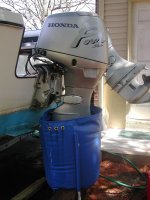I have a few maintenance questions:
Please point me to a previous post if it is covered somewhere>
1.What is the best way to flush the Honda 40 HP engines at the end of each day [docked] when you are in salt water for a few weeks.
I have been removing the engine cover and back flushing the rubber tube that is connected to the cooling system exit port on the Starboard side of the engine, until water is draining out of all ports below.
I know there is port near the gear oil port but it will not flush the upper part of the system described above. I have tried the earmuffs, with the engines in the up position and turned off but again no water out the cooling exit port.
I know that its ok to run the engines in neutral and down with muffs on [and water flowing in ] when boat is out of water, but that doesn't work when I am docked somewhere.
I asked one Honda mechanic about running the engines [in neutral] with muffs on, and water on - with the engine in the up position and he said lubrication of the engine at that angle might cause a problem.
I did search for some of this under engine flush - may have had the wrong search word.
2. I am trying to learn about shore power - I think mine is 15 amp - as the manual said we needed 15 amp if battery charger was installed.
I am using the Cafarano dehumidifer with fan when not in the boat and the circuit brakers handle it fine
I purchased a Cafarano electric heater [for boat, shop, home etc] I can only run it on the low fan and heat setting which never really dries out the boat when I am hooked up to shore power [and on the boat] . The higher setting throw the circuit breaker. I could see using this for winter cruising to explore several Puget Sound Marinas this winter
So - any suggestions for an electric heat system [at shore power] when I don't want to run the Wallace stove?
Is it difficult to upgrade to a higher amp system?
Different Marinas have different types of amperage - how do you manage that.
3. Do most of you who run the Wallace or alcohol stoves have a CO detector on board?
Especially when docked and the Bimini cover is closed and CO could accumulate in the enclosed area.?
Thanks
Jim
Please point me to a previous post if it is covered somewhere>
1.What is the best way to flush the Honda 40 HP engines at the end of each day [docked] when you are in salt water for a few weeks.
I have been removing the engine cover and back flushing the rubber tube that is connected to the cooling system exit port on the Starboard side of the engine, until water is draining out of all ports below.
I know there is port near the gear oil port but it will not flush the upper part of the system described above. I have tried the earmuffs, with the engines in the up position and turned off but again no water out the cooling exit port.
I know that its ok to run the engines in neutral and down with muffs on [and water flowing in ] when boat is out of water, but that doesn't work when I am docked somewhere.
I asked one Honda mechanic about running the engines [in neutral] with muffs on, and water on - with the engine in the up position and he said lubrication of the engine at that angle might cause a problem.
I did search for some of this under engine flush - may have had the wrong search word.
2. I am trying to learn about shore power - I think mine is 15 amp - as the manual said we needed 15 amp if battery charger was installed.
I am using the Cafarano dehumidifer with fan when not in the boat and the circuit brakers handle it fine
I purchased a Cafarano electric heater [for boat, shop, home etc] I can only run it on the low fan and heat setting which never really dries out the boat when I am hooked up to shore power [and on the boat] . The higher setting throw the circuit breaker. I could see using this for winter cruising to explore several Puget Sound Marinas this winter
So - any suggestions for an electric heat system [at shore power] when I don't want to run the Wallace stove?
Is it difficult to upgrade to a higher amp system?
Different Marinas have different types of amperage - how do you manage that.
3. Do most of you who run the Wallace or alcohol stoves have a CO detector on board?
Especially when docked and the Bimini cover is closed and CO could accumulate in the enclosed area.?
Thanks
Jim

